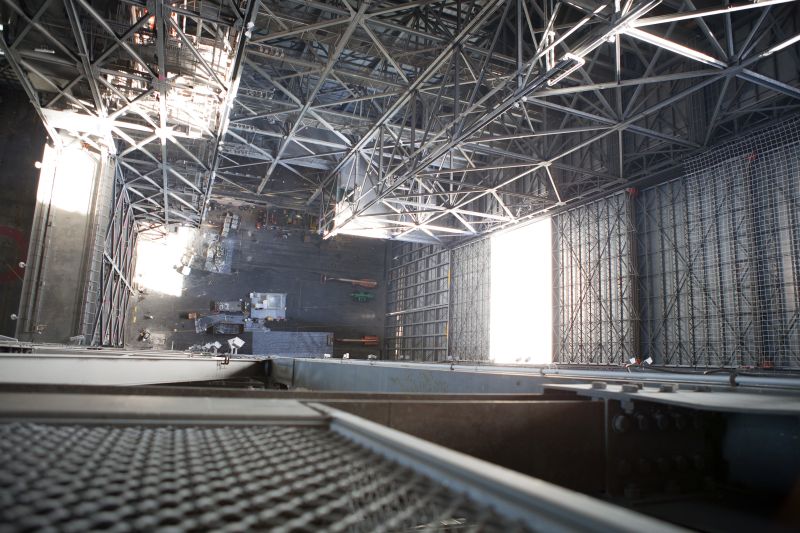
For anyone who has made the journey to NASA’s Kennedy Space Center, the view is unforgettable. As one drives along NASA Causeway (past the lush trees and, sometimes, alligators), the iconic Vehicle Assembly Building (VAB, formerly the Vertical Assembly Building)—one of Florida’s largest buildings at a staggering height of 525 feet—comes into sight, resplendent with its American flag and “meatball” logo. For many, the VAB represents the ingenuity of the American space program.
Completed in 1965, the building was the home of Saturn V rockets and space shuttle stacks well before the vehicles left their launch pads. Now, the VAB is getting ready for NASA’s next-generation spacecraft and launch vehicles, as it undergoes modifications for the Orion/Space Launch System (SLS) program.

Because the SLS rockets will be larger (and, ultimately, more powerful) than the Saturn V’s of the 1960s and 1970s, NASA Kennedy’s Ground Systems Development and Operations (GSDO) Program has been hard at work getting the VAB ship-shape (or “spaceship-shape”) to process the new launch vehicles. A NASA article by Linda Herridge details these modifications, which include:
- A new platform system to allow access to the Orion spacecraft and SLS vehicles. NASA announced that in 2013, the previously used platforms in High Bay 3 were removed. The new system, which has 10 platform levels, will be able “to move in and out, and translate up and down as needed,” according to NASA. For the first time in the VAB’s history, the building will be able to accommodate and service different vehicle configurations without major construction efforts. Computer-aided design (CAD) is being used to envision how needed infrastructure (power cables, high pressure fluid lines, communication lines, etc.) will move with this platform system.
- In addition, NASA announced that the high bay “will accommodate the 355-foot-tall mobile launcher that will carry the rocket and spacecraft atop the crawler-transporter to the launch pad.”
- Low-voltage power sources are being upgraded, starting in High Bay 3. State-of-the-art fiber optic cabling is replacing copper wiring and lead-shielded cabling from the Apollo and Shuttle programs. In addition, water, sewage, and drainage piping will be upgraded, along with the building’s fire protection system.
- NASA announced that all four of the vertical-lift doors have been “repaired and upgraded.” The agency also stated: “In the F tower, a second elevator will be added. Old or unnecessary ground support equipment has been removed, including large beams in High Bay 1, where the Apollo/Saturn V was stacked, and a 125-ton bridge crane in High Bay 4 that has not been used in 20 years.”
- As the building has aged, naturally some corrosion from the elements can be expected. Investigations are underway to determine possible steel/ground support equipment corrosion and aging of concrete. Any affected areas will undergo repairs and revitalization.
Staff members supervising this renovation sounded enthusiastic about the “new-generation” VAB and its future. Jose Lopez, VAB senior project manager, communicated this feeling: “The VAB project team, along with the entire GSDO Program office, continues to be on fire with excitement as we take a concept of providing a reconfigurable high bay, and initiate the construction effort.”
However, time is of the essence, and those working on the project realize their work is far from finished. But the work on this historic building has become a matter of pride.

Steve Starr, senior project manager with Vencore on the Engineering Services Contract, related: “We have a lot of work to complete, and now is the time to refurbish and upgrade the VAB before we begin processing launch vehicles. … When we consider the monumental effort that went into designing and constructing the VAB, all done in the early 1960s without the technology we have today, I am proud to be a part of renovating and upgrading the facility to support the next generation of human spaceflight.”
While the VAB undergoes a period of revitalization, preparations are underway for the first Orion capsule test flight, Exploration Flight Test 1 (or EFT-1). The test capsule is currently being processed in the recently renamed Neil Armstrong Operations and Checkout Building.
Scheduled to launch Thursday, Dec. 4, from Cape Canaveral Air Force Station’s Launch Complex 37B, this Delta IV Heavy-powered flight has been characterized as “this generation’s Apollo 4.” The test will take the Orion spacecraft to a high-apogee orbit and will conclude with a high-energy reentry, validating the spacecraft’s systems and heat shielding. This test is appropriate because Orion is slated to take astronauts and space travelers beyond Low-Earth Orbit (LEO) for the first time since the end of the Apollo program. The first test of the SLS launch vehicle is scheduled to take place in 2017.
SLS will be NASA’s manned “ticket” to asteroids and perhaps even our nearest planetary neighbor, Mars. And it will get its start inside the signature building that propelled the U.S. manned space program to the Moon, to Earth’s orbit, and back.
Want to keep up-to-date with all things space? Be sure to “Like” AmericaSpace on Facebook and follow us on Twitter: @AmericaSpace




As long as they keep chunks from hitting SLS from above.